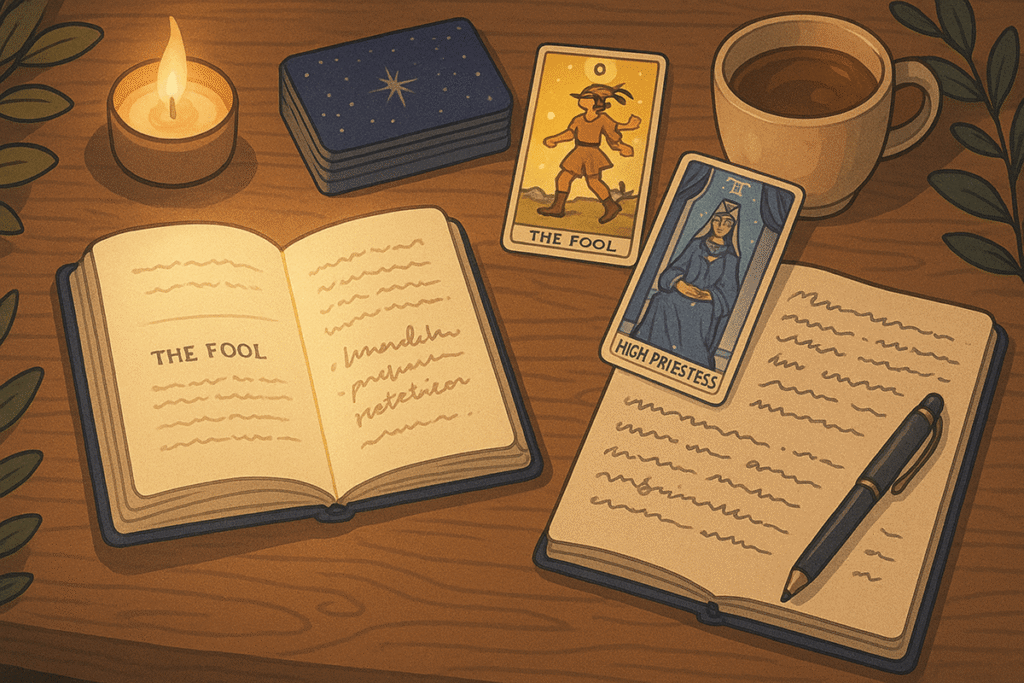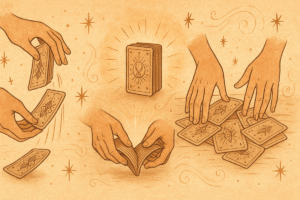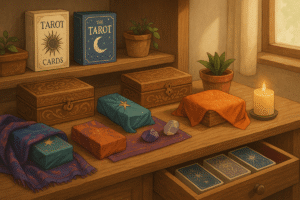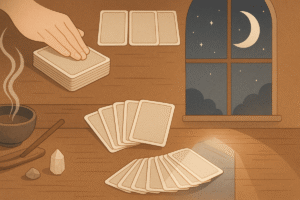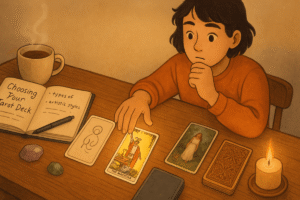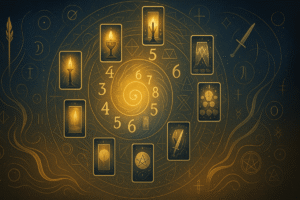Table of Contents
When you first open a new tarot deck, there’s usually a small booklet tucked inside. Some people call it the Little White Book, or LWB for short. Others just refer to it as the guidebook. Whatever you call it, that thin pamphlet often represents your first real introduction to the cards you’re holding. I remember feeling both excited and slightly overwhelmed when I got my first deck, flipping through those pages trying to absorb everything at once.
The thing is, these guidebooks can be incredibly useful, but they’re not meant to be the final word on what your cards mean. They’re more like a helpful friend offering suggestions rather than a teacher handing down unchangeable truths. Understanding how to use that little book wisely can shape your entire relationship with tarot going forward.
Starting With What’s Already There
The guidebook that comes with your deck serves a specific purpose. It gives you somewhere to begin. For someone who’s never worked with tarot before, staring at 78 illustrated cards without any context can feel paralyzing. Where do you even start? What does this card with the tower on fire actually represent? The guidebook answers those immediate questions.
Most guidebooks follow a similar format. They’ll give you a brief description of each card, maybe a few keywords, and sometimes upright and reversed meanings. Some are more detailed than others. The guidebook that came with my second deck was surprisingly thorough, with little stories for each card. My first deck’s booklet was pretty bare bones, just a paragraph per card. Both were helpful in their own way.
When you’re beginning, read through the guidebook. Get familiar with the basic framework it provides. Notice which cards seem to have themes that resonate with you immediately, and which ones feel confusing or abstract. This initial read through isn’t about memorization. It’s about getting a general sense of the landscape you’re entering.
The Guidebook Is Not an Authority
Here’s something I think many beginners don’t realize at first. The person who wrote your guidebook was interpreting the cards through their own understanding and experience. They made choices about what to emphasize and what to leave out. Their interpretation might be traditional, or it might be quite personal to them. Either way, it’s one perspective among many possible perspectives.
Tarot has been around for centuries, and different traditions have developed different ways of reading the cards. The meanings in your guidebook might align with Rider Waite Smith traditions, or they might draw from other systems entirely. Some deck creators intentionally reinterpret cards to fit their unique vision. This means the guidebook is offering you a viewpoint, not handing down universal law.
I’ve found it helpful to think of the guidebook as a conversation starter rather than a conversation ender. When it says the Three of Swords relates to heartbreak and sorrow, that’s valuable information. But perhaps for you, when you see that card, you think about difficult but necessary truths, or the clarity that comes after emotional release. Neither interpretation cancels out the other. They can coexist.
Creating Your Own Card Meanings Journal
This is where your practice becomes truly personal. Alongside using the guidebook, start keeping a journal specifically for your tarot observations. You don’t need anything fancy. A simple notebook works perfectly well. Each time you draw a card or do a reading, write down what the guidebook says, and then write down what you notice.
What feelings come up when you look at this particular card? What details in the artwork catch your attention? If you drew this card in response to a question, how might it relate to your situation in ways the guidebook didn’t mention?
Sometimes you’ll find your personal associations align closely with the guidebook. Other times, you might develop completely different connections. I have one card that the guidebook describes as representing conflict and competition, but every time I draw it, it seems to be telling me to stand my ground and trust my abilities. Over time, that’s become what the card means in my practice. The guidebook gave me the traditional framework, but my journal helped me discover my own language with that card.
Your journal becomes a companion document to the guidebook. When you’re doing a reading months from now, you can check both resources. Maybe the guidebook’s interpretation speaks to the situation. Maybe your own notes resonate more strongly. Perhaps it’s a combination of both that reveals the most insight.
Noticing Patterns Over Time
As you continue working with your deck and journaling your experiences, patterns will start emerging. You might notice that certain cards appear frequently when you’re dealing with specific types of situations. Or you might realize that your interpretation of a card has evolved from what you first thought it meant.
The guidebook stays static, which actually makes it a useful anchor point. You can always return to it and see where you started. But your journal grows and changes with you. This is natural and healthy. Your understanding deepens. Your relationship with the cards becomes more nuanced.
There have been cards I initially didn’t connect with at all. The guidebook’s description felt distant or abstract. But after drawing that card several times and writing about the context each time, I started seeing threads I hadn’t noticed before. The meaning became clearer through repetition and reflection, not through memorizing what someone else wrote.
When the Guidebook Feels Too Limiting
At some point, you might find yourself feeling constrained by your deck’s guidebook. The descriptions might start to feel too brief or too rigid for the complex situations you’re exploring. This is actually a positive sign. It means you’re ready to expand your understanding beyond that initial framework.
This doesn’t mean throwing the guidebook away. It means recognizing it for what it always was, a starting point. You can seek out other resources, like more comprehensive tarot books or online communities where people discuss their interpretations. But keep prioritizing your own observations and experiences. Those matter more than any expert’s opinion because this is your practice.
I still occasionally flip through my original guidebooks, especially when I’m feeling stuck on a card’s meaning. Sometimes returning to that basic, simple description helps me remember what I might be overcomplicating. Other times, I just read it and think about how far my understanding has come since then.
Balancing Structure With Intuition
One challenge beginners often face is figuring out how much to rely on the guidebook versus their own intuitive responses to the cards. There’s no perfect formula for this. Some people naturally lean more toward studying traditional meanings. Others immediately connect with cards on an intuitive, gut feeling level.
The guidebook provides structure. Structure is genuinely helpful, especially when you’re learning something new. It gives you vocabulary and concepts to work with. But tarot also invites you to notice what emerges when you sit with a card and let your mind wander. What memories surface? What questions arise?
I think the sweet spot is allowing both to inform your practice. Use the guidebook to understand the general territory each card occupies, then use your journal and your intuitive responses to explore the specific landscape. Let them work together rather than treating them as opposing approaches.
Your Guidebook as Historical Record
Years into your tarot practice, that worn little guidebook might become something different entirely. It transforms into a record of where you began. You’ll remember what it felt like to need those basic definitions, to feel uncertain about whether you were interpreting cards correctly.
Perhaps you’ll get additional decks over time, each with its own guidebook offering slightly different takes on the same cards. Comparing them can be fascinating. You’ll notice where different authors agree and where they diverge. This comparison itself becomes a learning tool, showing you just how much room there is for personal interpretation in tarot work.
The guidebook doesn’t disappear in importance. It just changes roles. Instead of being your primary teacher, it becomes part of your tarot history, a reminder of your journey with these particular cards.
Creating a Practice That Works for You
What matters most is developing an approach that feels sustainable and meaningful to you. Some people will always check the guidebook first before forming their own impressions. Others prefer to look at the card, write down their immediate thoughts, and only then check what the guidebook says. Both methods work.
The goal isn’t to eventually not need any guidance at all. The goal is to use the guidebook as a tool among other tools, including your own growing knowledge and intuition. Let it support your practice without limiting it. Trust that your personal connections to the cards are valid even when they differ from published interpretations.
Your tarot guidebook is genuinely valuable. It offers you a foundation and a common language used by many readers. But your own experiences, observations, and intuitive hits are equally valuable. Perhaps they’re even more valuable because they’re uniquely yours. The guidebook helps you begin the conversation with your cards. Your journal and your practice help you deepen that conversation over time.
Starting with the guidebook and then building your own understanding alongside it creates a rich, layered approach to tarot. You honor the traditions and wisdom that came before while also honoring your own voice and perspective. That balance, I think, is where the most meaningful readings happen.
Frequently Asked Questions
What if my interpretation of a card completely differs from what the guidebook says?
This is actually a sign that your intuition is developing, not that you’re doing something wrong. Your personal connection to a card can be just as valid as the traditional meaning in the guidebook. When this happens, write down both interpretations in your journal and notice over time which one proves more meaningful in your readings. The guidebook offers one perspective, but your lived experience with the cards builds another equally valuable layer of understanding.
Should I read the guidebook before or after looking at the cards?
Many experienced readers suggest looking at the card first and writing down your immediate impressions before checking the guidebook. This approach helps develop your intuitive reading skills while still benefiting from the guidebook’s wisdom. However, some people prefer reading the guidebook first to have a framework. Try both methods and see which feels more natural for your learning style. There’s no single correct approach.
Is it okay to only use parts of the guidebook’s interpretation instead of the whole meaning?
Absolutely. In fact, this is often more helpful than trying to apply every detail the guidebook provides. When a guidebook gives you multiple themes or keywords for a card, focus on whichever aspect resonates most strongly with your question or situation. Not every element of a card’s meaning will be relevant every time you draw it. Think of the guidebook as offering suggestions rather than requirements.
How do I know when I’m ready to move beyond my deck’s guidebook?
You’ll likely feel it naturally when the guidebook starts feeling too limiting or when you find yourself already knowing what a card might suggest before you check the book. This doesn’t mean completely abandoning the guidebook, but rather expanding your resources to include other books, your own journal notes, or online communities. You’re ready when you feel curious about deeper layers of meaning that your current guidebook doesn’t address.

